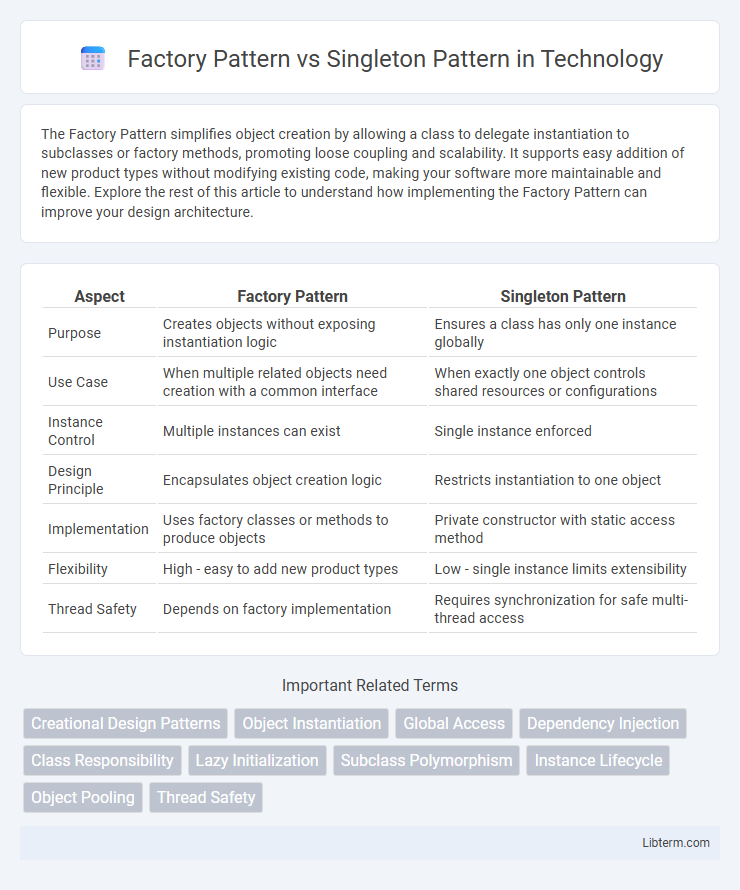The Factory Pattern simplifies object creation by allowing a class to delegate instantiation to subclasses or factory methods, promoting loose coupling and scalability. It supports easy addition of new product types without modifying existing code, making your software more maintainable and flexible. Explore the rest of this article to understand how implementing the Factory Pattern can improve your design architecture.
Table of Comparison
| Aspect | Factory Pattern | Singleton Pattern |
|---|---|---|
| Purpose | Creates objects without exposing instantiation logic | Ensures a class has only one instance globally |
| Use Case | When multiple related objects need creation with a common interface | When exactly one object controls shared resources or configurations |
| Instance Control | Multiple instances can exist | Single instance enforced |
| Design Principle | Encapsulates object creation logic | Restricts instantiation to one object |
| Implementation | Uses factory classes or methods to produce objects | Private constructor with static access method |
| Flexibility | High - easy to add new product types | Low - single instance limits extensibility |
| Thread Safety | Depends on factory implementation | Requires synchronization for safe multi-thread access |
Introduction to Design Patterns
Design patterns provide reusable solutions for common software design problems, enhancing code maintainability and scalability. The Factory Pattern simplifies object creation by encapsulating instantiation logic, allowing easy extension and variation of products without altering client code. The Singleton Pattern ensures a single, globally accessible instance of a class, controlling resource usage and maintaining consistent state throughout an application.
Overview of the Factory Pattern
The Factory Pattern is a creational design pattern that provides an interface for creating objects in a superclass while allowing subclasses to alter the type of instantiated objects. It promotes loose coupling by encapsulating the object creation process, making systems more scalable and maintainable. Unlike the Singleton Pattern, which restricts a class to a single instance, the Factory Pattern focuses on object creation flexibility and polymorphism.
Overview of the Singleton Pattern
The Singleton Pattern ensures a class has only one instance while providing a global access point to it, commonly used for managing shared resources like configuration settings or database connections. This design pattern restricts instantiation by using a private constructor and controls instance creation through a static method, guaranteeing thread-safe access in concurrent environments. Unlike the Factory Pattern, which focuses on creating objects without specifying the exact class, the Singleton Pattern emphasizes controlled instance management and global accessibility.
Key Features of Factory Pattern
Factory Pattern centralizes object creation, enabling the instantiation of different subclasses based on input parameters without exposing the creation logic to the client. It promotes loose coupling by delegating the responsibility of object creation to factory classes, which enhances code maintainability and scalability. This pattern supports easy extension by allowing new product types to be added with minimal changes to existing code, improving flexibility in complex systems.
Key Features of Singleton Pattern
The Singleton Pattern ensures a class has only one instance while providing a global access point to that instance, making it ideal for scenarios requiring controlled resource management or shared state. Key features include private constructors to prevent external instantiation, a static method that returns the single instance, and thread safety mechanisms to avoid multiple instantiations in concurrent environments. This pattern simplifies resource coordination by guaranteeing a single object controls consistent access throughout an application.
Core Differences Between Factory and Singleton
The Factory Pattern focuses on creating instances of different classes based on input or configuration, enabling flexible and scalable object creation, while the Singleton Pattern restricts a class to a single instance, ensuring controlled access to that sole object throughout the application. Factory Pattern promotes loose coupling by abstracting instantiation logic, whereas Singleton Pattern manages global state and lifecycle with thread-safe mechanisms or lazy initialization techniques. Unlike Singleton, Factory Pattern supports polymorphism and multiple instances, making it ideal for scenarios requiring various object types.
Use Cases for Factory Pattern
The Factory Pattern is ideal for scenarios where object creation logic is complex or needs to be decoupled from the client, such as when creating different types of products in a product suite or managing multiple configurations of a class. It provides flexibility to introduce new subclasses without altering existing code, making it suitable for frameworks and libraries that require extensibility. Common use cases include GUI toolkits with various widgets, document editors supporting multiple file formats, and systems needing runtime selection of product instances.
Use Cases for Singleton Pattern
Singleton Pattern is ideal for managing shared resources such as database connections, logging services, or configuration settings, ensuring only one instance exists throughout the application's lifecycle. It prevents redundancy and maintains global state consistency, which is crucial in scenarios requiring controlled access to a single resource. Unlike the Factory Pattern, which focuses on object creation flexibility, Singleton centralizes resource management and synchronization across different parts of an application.
Pros and Cons Comparison
The Factory Pattern promotes flexibility by enabling the creation of multiple related objects without specifying exact classes, enhancing code scalability and maintainability but introducing complexity in architecture and potential overhead. The Singleton Pattern ensures a single instance of a class, providing controlled access to shared resources and reducing memory usage, though it can lead to global state issues and hinder unit testing. Choosing between the two depends on whether the application requires controlled instance creation or simple, centralized access to a single object.
Choosing the Right Pattern for Your Project
Choosing the right design pattern depends on your project's needs: use the Factory Pattern when you require an interface to create related objects without specifying their concrete classes, enabling flexibility and scalability. Opt for the Singleton Pattern when a single instance of a class must control shared resources or coordinate actions across the system, ensuring global access and preventing multiple instantiations. Understanding object lifecycle, resource management, and system complexity guides selecting between Factory and Singleton Patterns to optimize maintainability and performance.
Factory Pattern Infographic

 libterm.com
libterm.com